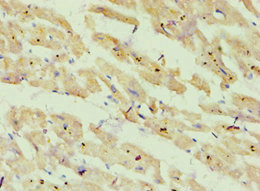
Immunohistochemistry of paraffin-embedded human heart tissue using CSB-PA002379ESR1HU at dilution of 1:100
ATP5O Antibody
CSB-PA002379ESR1HU
ApplicationsELISA, ImmunoHistoChemistry
Product group Antibodies
ReactivityHuman
TargetATP5PO
Overview
- SupplierCusabio
- Product NameATP5O Antibody
- Delivery Days Customer20
- ApplicationsELISA, ImmunoHistoChemistry
- CertificationResearch Use Only
- ClonalityPolyclonal
- ConjugateUnconjugated
- Gene ID539
- Target nameATP5PO
- Target descriptionATP synthase peripheral stalk subunit OSCP
- Target synonymsATP5O, ATPO, HMC08D05, MC5DN7, OSCP, ATP synthase peripheral stalk subunit OSCP, mitochondrial, ATP synthase subunit O, mitochondrial, ATP synthase, H+ transporting, mitochondrial F1 complex, O subunit, human ATP synthase OSCP subunit, oligomycin sensitivity conferral protein oscp-like protein, oligomycin sensitivity conferring protein
- HostRabbit
- IsotypeIgG
- Protein IDP48047
- Protein NameATP synthase peripheral stalk subunit OSCP, mitochondrial
- Scientific DescriptionMitochondrial membrane ATP synthase (F1F0 ATP synthase or Complex V) produces ATP from ADP in the presence of a proton gradient across the membrane which is generated by electron transport complexes of the respiratory chain. F-type ATPases consist of two structural domains, F1 - containing the extramembraneous catalytic core and F0 - containing the membrane proton channel, linked together by a central stalk and a peripheral stalk. During catalysis, ATP synthesis in the catalytic domain of F1 is coupled via a rotary mechanism of the central stalk subunits to proton translocation. Part of the complex F0 domain and the peripheric stalk, which acts as a stator to hold the catalytic alpha3beta3 subcomplex and subunit a/ATP6 static relative to the rotary elements.
- ReactivityHuman
- Storage Instruction-20°C or -80°C
- UNSPSC41116161





